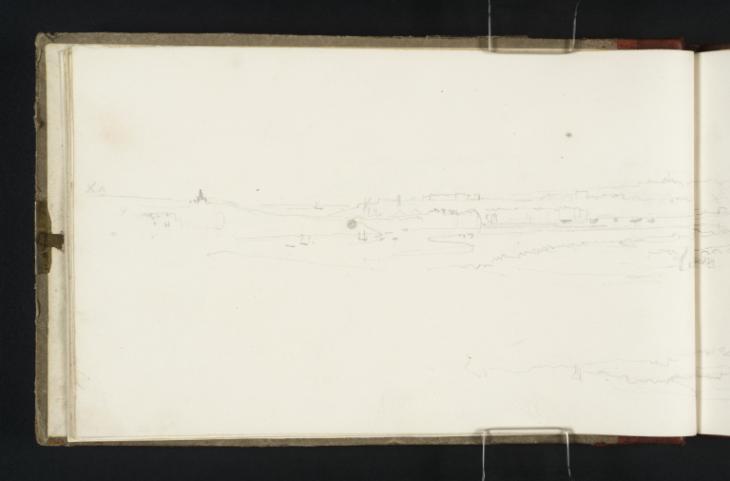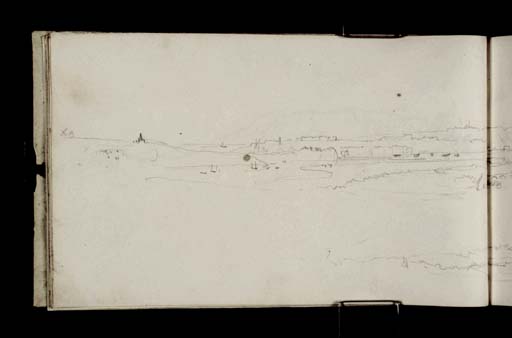Joseph Mallord William Turner A Bend of the River Medway, with Rochester Castle c.1821-2
Image 1 of 2
Joseph Mallord William Turner,
A Bend of the River Medway, with Rochester Castle
c.1821-2
Joseph Mallord William Turner 1775–1851
Folio 6 Verso:
A Bend of the River Medway, with Rochester Castle c.1821–2
D17217
Turner Bequest CXCVIII 6a
Turner Bequest CXCVIII 6a
Pencil on white wove paper, 113 x 187 mm
Accepted by the nation as part of the Turner Bequest 1856
References
1909
A.J. Finberg, A Complete Inventory of the Drawings of the Turner Bequest, London 1909, vol.I, p.604 under CXCVIII 6a–7, as ‘Bend of Medway, with Rochester Castle’.
1979
Eric Shanes, Turner’s Picturesque Views in England and Wales 1825–1838, London 1979, p.156.
1997
Eric Shanes, Turner’s Watercolour Explorations 1810–1842, exhibition catalogue, Tate Gallery, London 1997, pp.72–3 under nos.58 and 59.
The dominant prospect on this and the facing page describes a bend in the river Medway that had become familiar to Turner by the 1820s. In this half of the composition, the artist looks towards a distant insinuation of various Chatham landmarks; ship-building sheds and paraphernalia at the water’s edge, and the Brompton Barracks. Strood is off towards the left, and a depiction of Rochester straddles the gutter and continues on to the facing sheet. Briefly rendered boats are scattered across the stretch of water, demonstrating the atmosphere of an industrious waterway teeming with life and activity. For a more detailed description of the other half of this sketch, see the entry for folio 7 recto opposite (D17218).
Eric Shanes has connected this drawing with the Rochester, Stroud and Chatham engraving made by J.C. Varall for the Picturesque Views in England and Wales series, published in 1838 (Tate impressions: T05104, T06127), based on Turner’s lost watercolour of about 1836.1 Shanes positions this page as the original drawing upon which the later engraving and various studies and watercolours for it were based.2 The former shows a marked elaboration on the liveliness evident in the boats cutting through the present rendering. Shanes pays particular attention to what he calls a ‘landscape of activity’ in the engraving, in spite of its stilted handling.3 Labourers abound in the foreground, tending to various agricultural tasks, and a mother feeds her child under their gaze.
Shanes has also highlighted a group of works likely to have informed a delicate watercolour study for Rochester, Stroud and Chatham, Medway of about 1830 (Tate D25231; Turner Bequest CCLXIII 109), itself related to the Rochester, Stroud and Chatham, Medway engraving outlined above.4 In addition to the present page, the art historian cites folios 7 recto, 8 verso, 9 recto, 10 recto, and 83 verso (D17218, D17221–D17222, D17224, D17350) as the studies from which this composition is likely to have been elaborated.5
Towards bottom right, jagged pencil lines emerge from the gutter and peter out near the centre of the page. These represent the tail-end of a second rendering of the Medway landscape on the facing page, made with the sketchbook turned upside down.
Turner seems to have maintained a nostalgic relationship with Rochester.6 He had composed a view of the city for John Walker’s topographical publication The Copper-Plate Magazine in 1794, the first engraved work (Tate impressions: T05881–T05882)7 to be based on one of his watercolours (Sterling and Francine Clark Art Institute, Williamstown, Massachusetts).8 The River Medway at Rochester is certainly given a significant degree of attention in the present book. For further studies within these pages, see the inside front cover, and folios 6 verso, 7 recto, 7 verso, 8 verso, 9 recto, 9 verso, 10 recto, 58 verso, 59 recto, 79 verso, 80 recto, 81 recto, 81 verso and 83 verso (D40685, D17217–D17219, D17221–D17224, D17303–D17304, D17342–D17343, D17345–D17346, D17350). Also see the Medway sketchbook of 1820 (Tate; Turner Bequest CXCIX), particularly the entry for folio 18 recto (Tate D17394; Turner Bequest CXCIX 18a).
Elsewhere, see Tate D00117 and D00180 (Turner Bequest VIII C, XVII E), possibly from about 1793; Tate D00158–D00159 and D01109 (Turner Bequest XV B, C, XXXVI O) from 1794; the River and Margate sketchbook of around 1805–9 (Tate D06400, D06405, D06407, D06449–D06450, D06480, and D06482; Turner Bequest XCIX 25a, 28, 29, 53a–54, 69a, 70a); and the Gravesend and Margate sketchbook of about 1832 (Tate D27352–D27353, D27356; Turner Bequest CCLXXIX 45a–46, 47a). Also see three watercolour studies (Tate D25231, D25286, D25474; Turner Bequest CCLXIII 109, 164, 351) and Rochester Castle from the River of about 1793 (Tate D00160; Turner Bequest XV D). Casting a wider net, see also Rochester of 1795 (Manchester Art Gallery).9
Maud Whatley
January 2016
How to cite
Maud Whatley, ‘A Bend of the River Medway, with Rochester Castle c.1821–2 by Joseph Mallord William Turner’, catalogue entry, January 2016, in David Blayney Brown (ed.), J.M.W. Turner: Sketchbooks, Drawings and Watercolours, Tate Research Publication, February 2017, https://www


